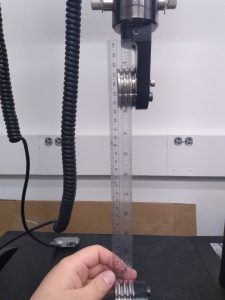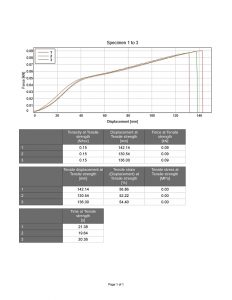Tensile strength is defined as the strength of a material under tension (pulling) as distinct from compression, torsion, or shear. The definition is vague because it covers a wide range of properties including
- Breaking force,
- Breaking strength,
- Breaking tenacity,
- Breaking toughness,
- Chord modulus,
- Elongation,
- Elongation at break,
- Elongation at rupture,
- Initial modulus,
- Knot-breaking force,
- Knot-breaking strength,
- Linear density,
- Loop breaking force,
- Lop breaking strength,
- Single-strand breaking force,
- Single-strand breaking strength,
- Strength, and
- Tenacity.
However, the test for most of these properties is the same: pulling the yarn apart under controlled conditions. The Instron 5969 directly measures the force of tension and the elongation. The Bluehill operating software takes sample measurements (such as thickness) which it uses to calculate the rest. The optimal grips for tensile testing are split capstan grips, which are designed to avoid problems such as slipping and breaking prematurely at the grip site. The specimen wraps around the outside, while the trailing ends are held tightly in the middle as the load increases. Smooth capstan grips are used for flat tapes, while grooved capstans are more useful for braided or twisted cords.
Sample Preparation
The ASTM method for testing tensile properties of yarn is D2245, and samples should be prepared accordingly. A sample’s thickness must be between 0.5mm (0.02 in) and 3.2 mm (1/8 in). At a minimum, cord samples should be 480 mm (18.9 in) long, and tape samples should be 500 mm (19.7 in) long. Samples are loaded into a capstan as shown here:
The bottom capstan should be loaded in the reverse of the sequence shown. The distance between the two capstans should be 250±3 mm, measured between the split of each head as shown.

The capstans in the MCL have a maximum capacity of 2.5 kN. For context, a single strand of polyester, medium weight yarn breaks around 0.09 kN.
Testing
An extra sample or two should be prepared, which will be used to calibrate for the time-to-break requirement in the ASTM standard of 20±3 seconds. Load the extra sample and use a starting displacement rate around 10 mm/min. Then use the time and displacement at break to change the displacement rate to achieve that distance after 20 seconds. After altering the method to match the appropriate rate, testing should be fast and efficient.
The results will look something like this

